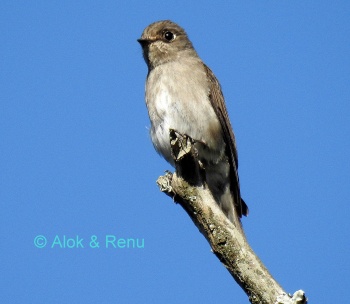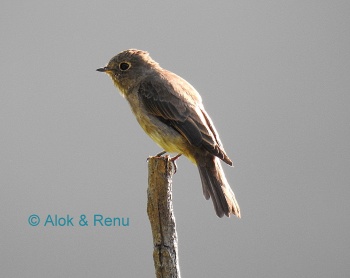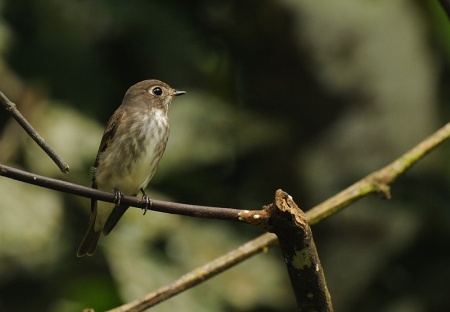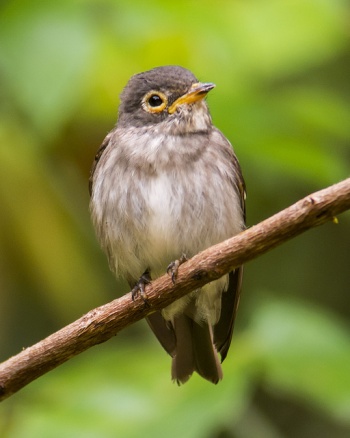- Muscicapa sibirica
Identification

Photo © by Alok Tewari
Dwarahat, Alt. 4800 ft. Uttarakhand Himalayas, India, October-2018
13-14cm (5-5½ inch)
- Dark grey brown above
- White throat
- White half collar
- Centre of lower breast and belly are white
- Buff wingbar
- Breast and flanks streaked dark grey brown
- Dark spots around center of whitish undertail coverts
- Pale sub-moustachial stripe
- Dark malar stripe
- White eyering
- Short dark bill
- Black feet
- Sexes alike
Juvenile
- Pale spots above
- Mottled breast
- Buff tipped wing coverts
Similar Species
There is more than a striking similarity to the Grey-streaked Flycatcher when they are darting about in the willows. But the obvious differences are the buffy wing bar rather than white of the Grey-streaked and the wing extension is considerably shorter than the Grey-Streaked. The Dark-sided is also a browner bird rather than ash-grey of the Grey-Streaked.

Photo © by Alok Tewari
Sat Tal Forest, Alt. 5500 ft. Uttarakhand Himalayas, India, October-2018
Distribution
Asia: found in Russia, Siberia, Kazakhstan, Afghanistan, Mongolia, China, Tibet, Nepal, Pakistan, India, Eastern and Western Himalayas, Bangladesh, Bhutan, Korea, Japan, Taiwan, Hong Kong
Southeast Asia: Indochina, Myanmar, Laos, Vietnam, Cambodia, Thailand, Malaysia, Borneo, Malay Peninsula, Brunei, Singapore, Philippines, Indonesia, Greater Sundas, Sumatra and Java.
Taxonomy
Subspecies
There are 4 subspecies[1]
- M. s. sibirica:
- South-eastern Siberia to Japan; winters to Indochina and Greater Sundas
- M. s. gulmergi:
- Western Himalayas (eastern Afghanistan to Kashmir and Garhwal)
- M. s. cacabata:
- M. s. rothschildi:
Habitat
Broadleaf evergreen forest and secondary growth; forest edges up to 1,160 meters; river/Paddy areas and gardens.
Behaviour
Diet
The diet includes small invertebrates, flies and midges etc which are aerially hawked.
Breeding
The nest is cup-shaped nest which is built by the female. The clutch consists of 3-4 pale green eggs with red markings.
References
- Clements, J. F., T. S. Schulenberg, M. J. Iliff, D. Roberson, T. A. Fredericks, B. L. Sullivan, and C. L. Wood. 2015. The eBird/Clements checklist of birds of the world: v2015, with updates to August 2015. Downloaded from http://www.birds.cornell.edu/clementschecklist/download/
- Avibase
- Handbook of the Birds of the World Alive (retrieved November 2014)
- Wikipedia
- BF Member observations
Recommended Citation
- BirdForum Opus contributors. (2024) Dark-sided Flycatcher. In: BirdForum, the forum for wild birds and birding. Retrieved 27 April 2024 from https://www.birdforum.net/opus/Dark-sided_Flycatcher
External Links
GSearch checked for 2020 platform.1





